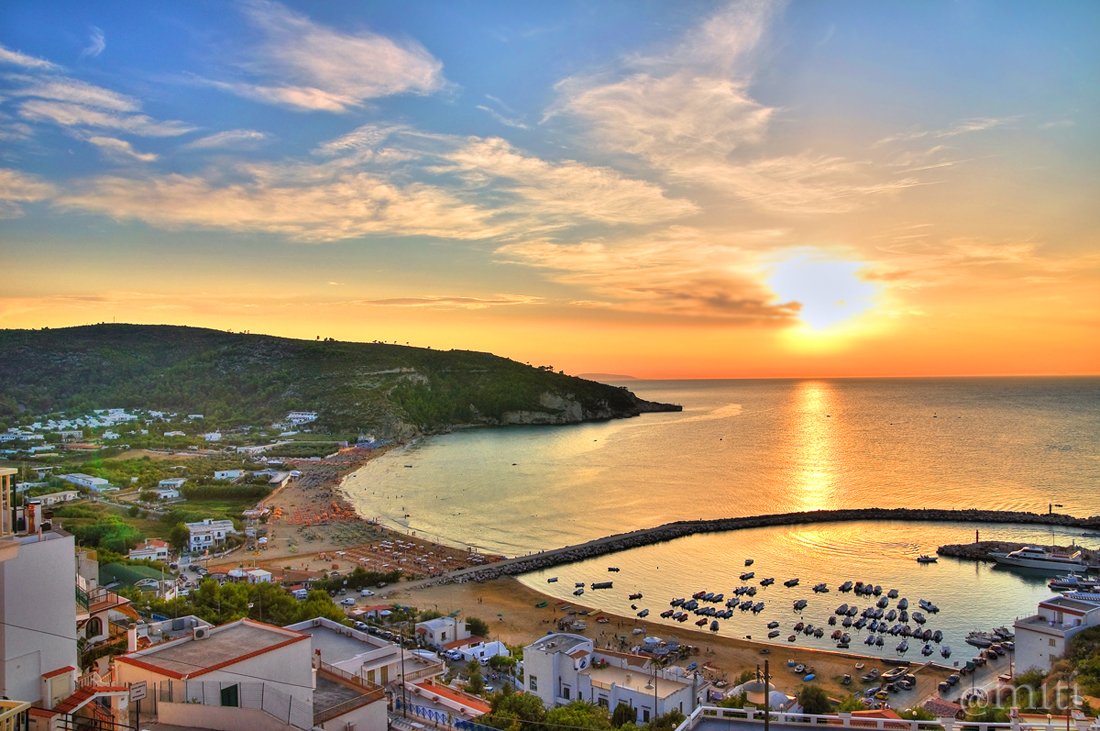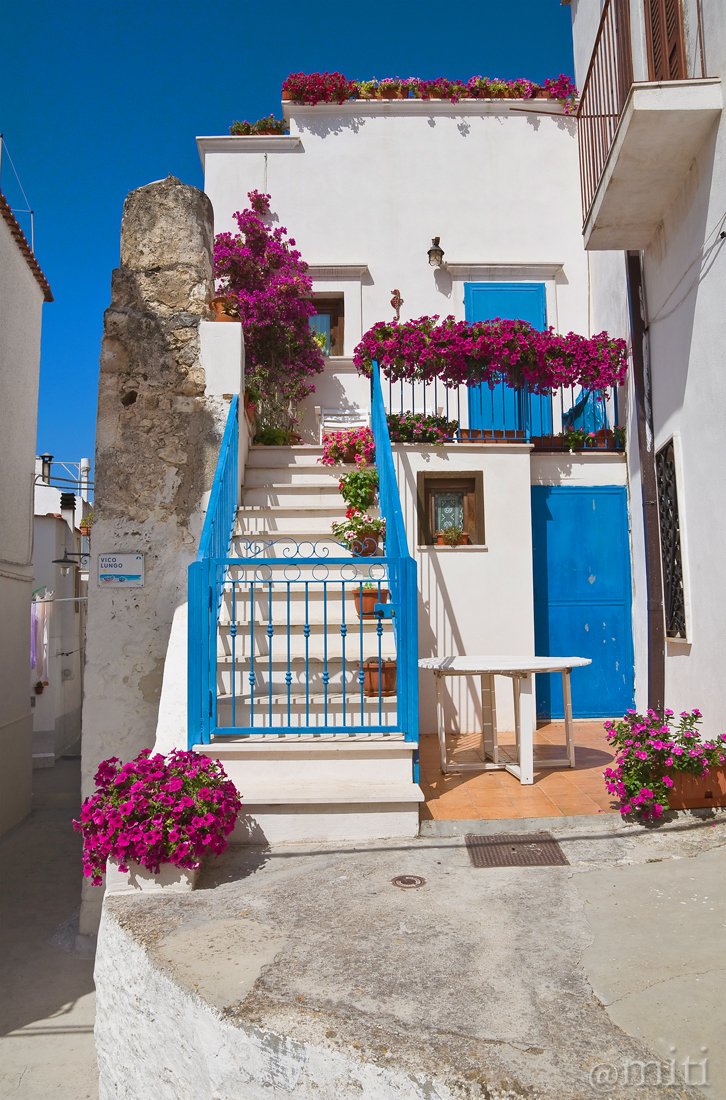
A panoramic view of Peschici (Author's photo - All rights reserved)
Vista panoramica di Peschici (Immagine dell'autore - tutti i diritti sono riservati)



Ciao a tutti,
questo è un viaggio attraverso l'Italia. Posterò una foto al giorno con una brevissima descrizione. Spero vi piaccia!

Peschici è un piccolo borgo della provincia di Foggia, nella regione italiana meridionale della Puglia. È una città di mare sulla cima di un promontorio che si erge a oltre 100 metri sopra il mare Adriatico, con vista sulla baia sottostante. E' sia una località balneare che un luogo di grande interesse storico e fa parte del Parco Nazionale del Gargano e della Comunità Montana del Gargano.
L'attuale nome di Peschici è tuttavia di origine slava. Nel 970 dC un capitano slavo che serviva sotto l'imperatore Ottone I con il suo esercito liberò l'intera penisola garganica dei Saraceni e come ricompensa l'imperatore stabilì nell'area due colonie di coloni slavi a Vico e Peschici.
Nella seconda metà dell'XI secolo i Saraceni furono definitivamente espulsi dal Gargano dai Normanni che costruirono un castello nel punto più alto di Peschici.
Federico II di Svevia lo rinforzò successivamente con le mura e una torre, chiamata del Ponte o "Rocca Imperiale"; il castello divenne a sua volta svevo, angioino, aragonese e infine una roccaforte spagnola. Originariamente Peschici era interamente circondata da mura e dotata di tre ingressi, la porta del Ponte, la Porta del Castello e la Porta Bassa.
Dal tardo medioevo Peschici seguì le sorti del Regno di Napoli fino all'Unità d'Italia nel 1861. Attualmente è un centro turistico ricco e importante.
Questa affascinante città di pescatori ha una ricca storia. Nonostante l'origine medievale, Peschici e i suoi dintorni sono di grande interesse archeologico e il Museo di Peschici contiene vari manufatti in pietra scoperti nella Valle di Sbernia, a sud della città.
Appena fuori città, vicino a Manacore, è possibile trovare una grotta preistorica (ora un parco archeologico), l'Abbazia di Santa Maria di Càlena (una delle più antiche abbazie italiane) e il Santuario della Madonna di Loreto, che, secondo la leggenda , è stato costruito da un gruppo di pescatori sopravvissuti al naufragio.
Il centro storico di Peschici sale dal porto alle fortificazioni del castello svevo. È caratterizzato da case bianche che degradano verso il mare e con strade strette che ricordano le città arabe. È qui cheè possibile vedere la "Porta del Ponte". Il centro storico di Peschici ospita numerose chiese di grande interesse tra cui la Chiesa di Sant'Elia e la Chiesa del Purgatorio.
Una tradizione locale risalente ai tempi dei Fenici è quella della pesca con i cosiddetti "Trabucchi", un antichissimo sistema di pesca utilizzato nel nord del Gargano costituito da pali di legno posti nelle rocce che ospitano una grande rete da pesca che è posta nell'acqua.
Cose da vedere: Il Centro Storico, la Chiesa di Sant'Elia, la Chiesa del Purgatorio, il Castello Svevo, il Ponte o "Rocca Imperiale", la Porta del Ponte, il Museo di Peschici, l'Abbazia di Santa Maria di Càlena, il Santuario della Madonna di Loreto, i Trabucchi.

Hello everyone,
I began a Photo Journey through Italy. I will post one photo every day with a little note of explanation. I hope you like it!

Peschici is a small town in the province of Foggia, in the southern Italian region of Puglia. It is a sea town on the top of a cliff-promontory that rises to more than 100 meters above the Adriatic Sea, overlooking the bay below. It is both a seaside resort town and a place of great historical interest and it is part of the Gargano National Park and the Mountain Community of Gargano.
The present name of Peschici is however of Slavic origin. In 970 AD a Slav captain serving under emperor Otto I with his army freed the whole Gargano peninsula of the Saracens and as a reward the emperor established in the area two colonies of Slavonic settlers in Vico and Peschici.
In the second half of the 11th century the Saracens were finally expelled from the Gargano by the Normans, and built a castle at the highest point of Peschici.
Frederick II of Swabia later reinforced it with the walls and a tower, called the Bridge or "Rocca Imperiale", that was to become in turn a Swabian, Angevin, Aragonese and finally a Spanish stronghold. Originally Peschici was entirely surrounded by walls, and equipped with three entrances, the gate of the Bridge, Gate of the Castle and Low Gate.
From the late Middle Ages Peschici followed the fortunes of the Kingdom of Naples until the Unification of Italy in 1861. Currently it is a rich and important tourist centre.
This charming fishing town has a rich history. Despite the medieval origin, Peschici and its surroundings are of great archaeological interest and the Museum of Peschici contains various stone artefacts discovered in the Sbernia Valley, south of the town.
Just outside the town, near Manacore, you'll find a prehistoric cave (now an archaeological park), the Abbazia di Santa Maria di Càlena (one of Italy's most ancient abbeys), and the Madonna di Loreto's Sanctuary, which, according to legend, was built by a group of fishermen who had survived shipwreck.
The old town of Peschici climbs from the harbor to the fortifications of the Swabian castle. It is characterized by whitewashed houses that slope down towards the sea and with narrow streets reminiscent of Arab cities. It is here that you can see the 'Gate of the Bridge'. The historic centre of Peschici contains several churches of interest including the Church of Saint Elias and the Church of the Purgatory.
A local tradition dating back to the time of the Phoenicians is that of fishing with the so-called 'Trabucchi', a very old fishing system used in northern Gargano that consists of wooden poles placed in the rocks that hold a very large fishing-net that is placed in the water.
Thing to see: The Historic Centre, the Church of Saint Elias, the Church of the Purgatory, the Swabian Castle, the Bridge or "Rocca Imperiale", the Gate of the Bridge, the Museum of Peschici, the Abbazia di Santa Maria di Càlena, the Madonna di Loreto's Sanctuary, the Trabucchi.

| Tipo di foto / Category | Paesaggio / Landscape view |
| Esposizione / Settings | 1/200 sec, ISO 200, f/10 |
| Camera | Nikon D5000 |
| Lente / Lens | Tamron SP 17-50mm f/2.8 XR Di II LD |
| Filtro / Filter | Polarizzatore Hoya / Hoya Polarizing filter |
| Cavalletto / Tripod | Manfrotto MKC3-P01 |
| Località / Location | Peschici (Foggia), Italia |
| Software | Photoshop / HDR |


Alleyway in the historical center (Author's photo - All rights reserved)
Vicolo del centro storico (Immagine dell'autore - tutti i diritti sono riservati)
